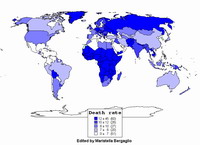Number of deaths in US jumps up in 2005
The number of deaths in the United States rose in 2005 after a sharp decline the year earlier.

But, U.S. life expectancy inched up to 77.9 from the previous record, 77.8, recorded for 2004. The increase was more dramatic in contrast with 1995, when life expectancy was 75.8, and 1955, when it was 69.6.
The U.S. continues to lag at least 40 other nations. Andorra, a tiny country in the Pyrenees mountains between France and Spain, has the longest life expectancy, at 83.5 years, according to the U.S. Census Bureau of 2004 international data. It was followed by Japan, Macau (which is part of China), San Marino and Singapore.
U.S. health officials said they believe the drop in deaths seen earlier may have been due to 2004's unusually mild flu season. Deaths from flu and lower respiratory disease jumped in 2005.
The new mortality data was released Wednesday in a report by the National Center for Health Statistics. It was a preliminary report, based on about 99 percent of the death records reported in all 50 states and the District of Columbia for 2005.
Last year, statistics from 2004 showed U.S. deaths fell to 2,397,615. It was a decline of about 50,000 from 2003, and was the largest drop in deaths in nearly 70 years. Some experts saw it as a sign of the triumph of modern medicine.
But the preliminary 2005 death count was up more than 50,000 - about 2,447,900 - almost back to the 2003 level.
"The best way to look at this is in five-year groupings, because every once in a while you are going to have an aberration," said Ken Thorpe, an Emory University health policy professor.
U.S. deaths numbered about 2,416,000 in 2001, 2,443,000 in 2002 and 2,448,000 in 2003, according to government data.
An unusually mild flu season in 2004 cut the flu death rate - the number of deaths per 100,000 people - by 7 percent. And it likely had a ripple effect by not worsening the condition of frail patients who ultimately died of something else, government health scientists said.
The 2005 flu season was closer to normal, and deaths from the virus rose by more than 3,000 from 2004. Deaths from chronic lower respiratory diseases increased by nearly 9,000.
Heart disease and stroke - the No. 1 and No. 3 killers - killed fewer people in 2005 than 2004. But the No. 2 cause of death, cancer, rose to about 559,000 from 554,000, according to the report.
The success against heart disease is at least partly due to better treatments, which overcame the impact of an aging, growing population, Thorpe said.
But with cancer deaths, there was no such offset in 2005. "That's unfortunate news," he said.
"You continue to hope with earlier detection diagnosis and treatment, we will pick these things up faster" and prevent deaths. But because a growing number of Americans lack health insurance, many may not be getting those services, Thorpe said.
A final report will be released later, and the numbers may change a little. Last year, when releasing its preliminary death data for 2004, the government reported a 77.9 life expectancy. That figure later dropped to 77.8 in the final report.
"If death rates from certain leading causes of death continue to decline, we should continue to see improvements in life expectancy," said study co-author Hsiang-Ching Kung, in a prepared statement.
Researchers also noted continued differences by race and sex. Life expectancy for whites in 2005 was 78.3, the same as in 2004. Black life expectancy rose from 73.1 in 2004 to 73.2 in 2005, but it was still nearly five years lower than the white figure.
Life expectancy for women continues to be five years longer than for men, the report also found. The infant mortality rate remained roughly the same as the previous year, about 6.9 per 1,000 live births.
Also, there were 5 percent increases in the rates for Alzheimer's disease, the No. 7 leading cause of death, and for Parkinson's disease, which was No. 14.
Subscribe to Pravda.Ru Telegram channel, Facebook, RSS!




